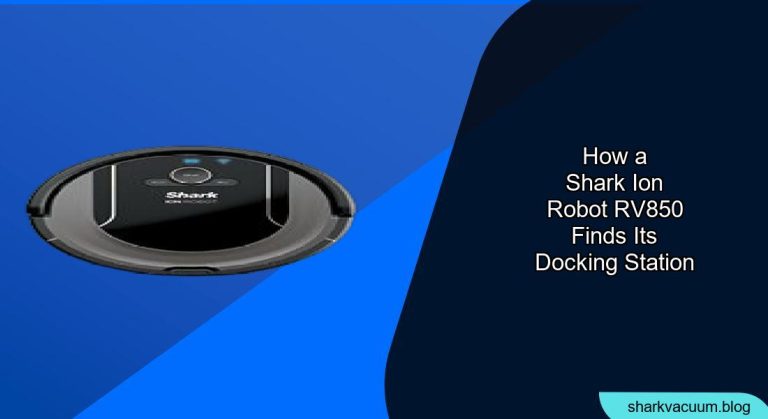Navigating the world of robot vacuums can be tricky, especially when understanding how these automated cleaners manage to return to their charging docks. One popular model, the Shark ION Robot RV850, uses a specific method to ensure it can find its way back home. If you’re curious about how this little cleaning companion manages this feat, you’ve come to the right place. This article will break down the process, offering insights into the technology and steps involved.
The ability of the Shark ION Robot RV850 to autonomously return to its dock is crucial for its usability. Without this function, the robot would simply stop wherever its battery runs low, requiring manual intervention. By understanding the mechanisms at play, users can optimize the placement of the dock and troubleshoot common issues that might prevent successful docking. Let’s dive in and explore how the RV850 accomplishes this seemingly magical task.
Table of Contents
Understanding the Shark ION Robot RV850 Docking System

The Shark ION Robot RV850 utilizes a combination of sensors and systematic cleaning patterns to effectively find its docking station. These include cliff sensors for navigation safety and, more importantly, sensors that help it detect the infrared signal emitted by the dock. This infrared signal acts like a beacon, guiding the robot back to its charging station.
Systematic Cleaning and Mapping
Before finding its dock, the RV850 employs a systematic cleaning pattern, usually moving in straight lines and using its bumper to detect obstacles. While it doesn’t create a persistent map like some higher-end models, it does remember its starting point. This spatial awareness, albeit temporary, aids in efficiently covering the cleaning area and assists in the return journey.
Infrared Navigation
The primary method the RV850 uses to locate its dock is through infrared (IR) navigation. The docking station emits an IR signal that the robot can detect. Once the robot enters the range of this signal, it uses it as a guide to align itself and approach the dock correctly.
Bumper and Obstacle Avoidance
As the RV850 approaches the dock, its bumper and obstacle avoidance sensors continue to function. This ensures that it doesn’t collide with the dock or any obstacles in its path, allowing for a smooth and damage-free docking process.
Step-by-Step: How the RV850 Finds Its Dock
The docking process can be broken down into several key steps:
- Low Battery Detection: The RV850 continuously monitors its battery level. When the battery reaches a certain low threshold, the robot initiates its docking sequence.
- Search Initiation: Once the docking sequence begins, the RV850 stops cleaning and starts searching for the infrared signal emitted by the docking station.
- Signal Acquisition: The robot roams around, systematically widening its search area until it detects the IR signal from the dock.
- Alignment and Approach: Upon detecting the signal, the RV850 aligns itself with the signal’s direction and begins to move towards the dock. It adjusts its trajectory based on the signal strength.
- Final Docking: As the robot nears the dock, it slows down to ensure a gentle connection. The charging contacts on the robot align with those on the dock, initiating the charging process.
Optimizing Docking Performance

Several factors can impact the RV850’s ability to find and dock successfully. Here are some tips to optimize its performance:
- Dock Placement: Place the docking station on a hard, level surface against a wall. Ensure there are no obstructions within a few feet around the dock.
- Infrared Signal Interference: Avoid placing the dock in direct sunlight or near other devices emitting infrared signals, as this can interfere with the robot’s navigation.
- Battery Health: Regularly monitor and maintain the robot’s battery. A degraded battery might not provide enough power for the robot to complete its docking sequence.
- Clean Sensors: Keep the robot’s sensors, including the IR sensor and bumper, clean and free from debris. Dust and dirt can impair their functionality.
Troubleshooting Common Docking Issues
Even with optimal conditions, the RV850 might occasionally struggle to find its dock. Here are some common issues and how to address them:
Robot Can’t Find the Docking Station
- Problem: The robot roams aimlessly without approaching the dock.
- Solution: Ensure the docking station is powered on and emitting an infrared signal. Try moving the dock to a more open area, away from potential sources of interference.
Robot Docks Incorrectly
- Problem: The robot approaches the dock but fails to make a proper connection.
- Solution: Check that the charging contacts on both the robot and the dock are clean and aligned. Make sure the dock is placed on a level surface.
Robot Stops Before Reaching the Dock
- Problem: The robot starts the docking sequence but stops before reaching the dock, indicating low battery.
- Solution: Replace or recharge the robot’s battery. Ensure the battery is properly installed and making good contact.
Robot Gets Stuck While Docking
- Problem: The robot encounters obstacles or gets trapped while trying to dock.
- Solution: Clear the area around the docking station of any clutter or obstacles. Ensure the robot has a clear path to the dock.
FAQ About Shark ION Robot RV850 Docking
How far can the Shark ION Robot RV850 be from its docking station and still find it?
The RV850 can typically detect the docking station’s infrared signal from up to 10-15 feet away, provided there are no significant obstructions or interference.
Can the Shark ION Robot RV850 find its dock in the dark?
Yes, the RV850 can find its dock in the dark because it relies on infrared signals, which are not dependent on visible light.
Does the Shark ION Robot RV850 create a map of my house to find its docking station easier?
No, the Shark ION Robot RV850 does not create a persistent map. It uses a systematic cleaning pattern and relies on the infrared signal from the docking station to navigate back.
What happens if the docking station is unplugged while the robot is cleaning?
If the docking station is unplugged, the robot will continue cleaning until its battery runs low. It will then attempt to find the dock, but without a signal, it will eventually stop and require manual placement on the charging station.
Tips, Warnings, and Best Practices
- Regular Maintenance: Regularly clean the robot’s sensors and charging contacts to ensure optimal performance.
- Avoid Relocation: Once you’ve found an optimal spot for the dock, avoid moving it frequently, as this can confuse the robot.
- Monitor Battery: Keep an eye on the battery’s performance and replace it when necessary to maintain the robot’s efficiency.
Conclusion
The Shark ION Robot RV850’s ability to find its docking station relies on a combination of systematic cleaning patterns, infrared navigation, and obstacle avoidance. By understanding these mechanisms and following the tips outlined in this article, you can ensure that your robot vacuum returns home reliably every time. This not only extends the life of your robot but also maximizes its convenience, allowing you to enjoy a cleaner home with minimal effort. So, optimize your dock placement, maintain your robot, and let the RV850 handle the rest.







